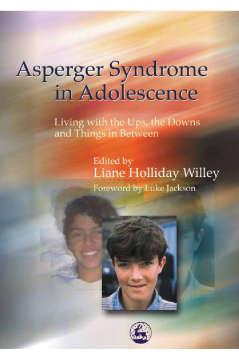
BOOK
Asperger Syndrome in Adolescence
Isabelle Henault | Jacqui Jackson | Mike Stanton | DeAnn Hyatt-Foley | Dennis Debbaudt | Steven Gutstein | Tony Attwood | Stephen Shore | Luke Jackson | Rebecca Moyes | Liane Holliday Willey | Lise Pyles
(2003)
Additional Information
Book Details
Abstract
Childhood and adult experiences of individuals with Asperger Syndrome (AS) are becoming increasingly well documented, yet the crucial formative teenage years have, so far, been neglected. Adolescence is a difficult time for any teenager, but when you have Asperger Syndrome this already emotionally complex time of life becomes all the more challenging. Reflecting the views of parents, professionals and those with AS themselves, this book tackles issues that are pertinent to all teenagers, such as sexuality, depression and friendship, as well as discussing topics like disclosure and therapeutic alternatives that are more specific to those with AS. This book aims to make the transition from child to adult as smooth as possible, and is an essential survival guide to adolescence.
contains a great deal of extremely useful information
ACT Bulletin
For people with Asperger Syndrome (AS) the teenage years can be particularly torrid, and consequently very challenging for carers and any staff working with sufferers or their families, yet little has been written on the subject. This substantial reader, containing contributions from many international experts, covers a broad range of issues.
Care & Health Magazine
Two areas that cause difficulties for young people with AS are friendship and sexuality. The book offers no hard and fast rules, but there is intelligent advice, plus website references to follow-up. This book would be a welcome addition to any department dealing with AS in adolescence.
Bulletin
this publication was certainly a welcome sight. Drawing from the experiences of parents, professionals and individuals with Asperger Syndrome this book covers the crucial areas of sexuality, friendships both appropriate and inappropriate, educational choice, disclosure, safety issues, therapies and feelings. Throughout the book each chapter and individual author combines theory and practice to provide clear and positive strategies/ideas/suggestions making that particular topic area seem a lot more achievable. A very valuable resource for all parents, carers and professionals facing the adolescent years of the person in their care.
Communication
First, it focuses on the issues that are paramount and unique to adolescence. Clinicians working with parents who have to deal with diagnosis during this period, and understanding why their child who managed previously, is now having so much trouble will benefit from a practical how-to appropriate to this age group. Second, this book brings together such diverse authorship that the reader cannot help but come away with a sense of the disorder from within, from loving family and from dedicated professionals working to problem solve side by side. Third, the chapters in the book cover areas that I have not seen spoken to with such thoughtfulness anywhere else, although real life demands their attention. This includes Asperger's and sexuality, friendship, safety, school options, siblings, disclosure, motor coordination and coping with the bittersweet news of diagnosis. These are questions I have been asked. Having a book available that addresses each of these issues by experts in the area from occupational therapists, to private inspector and special education teachers provides a framework and structure for more thoughtful therapeutic interventions.
The Canadian Child and Adolescent Psychiatry Review
There is a great need for practical strategies for this age group and this book offers many from a variety of sources. Every one of the chapters contains excellent insights into the effects of Asperger Syndrome and the experience of those it affects. The contributors also offer a range of practical strategies that professionals, parents and individuals with Asperger syndrome can try, in order to cope with the real agonies of the transition to adulthood.
Children Now
The variety of viewpoints makes the book of interest to numerous audiences, ranging from persons who know nothing about the condition to professionals. Since it has only been in the past few years that Asperger Syndrome has been generally recognized, teachers who did not receive their training very recently should find this book particularly informative. The number of students diagnosed with Asperger Syndrome is growing, and interest in the condition will undoubtedly increase. This book should be purchased for professional collections and by academic libraries that support programs related to autism spectrum disorders.
Education Book Reviews
